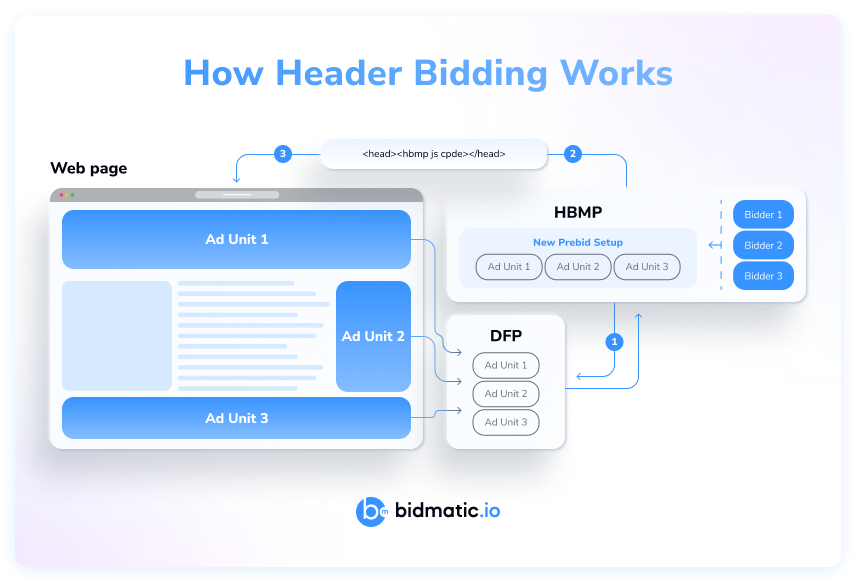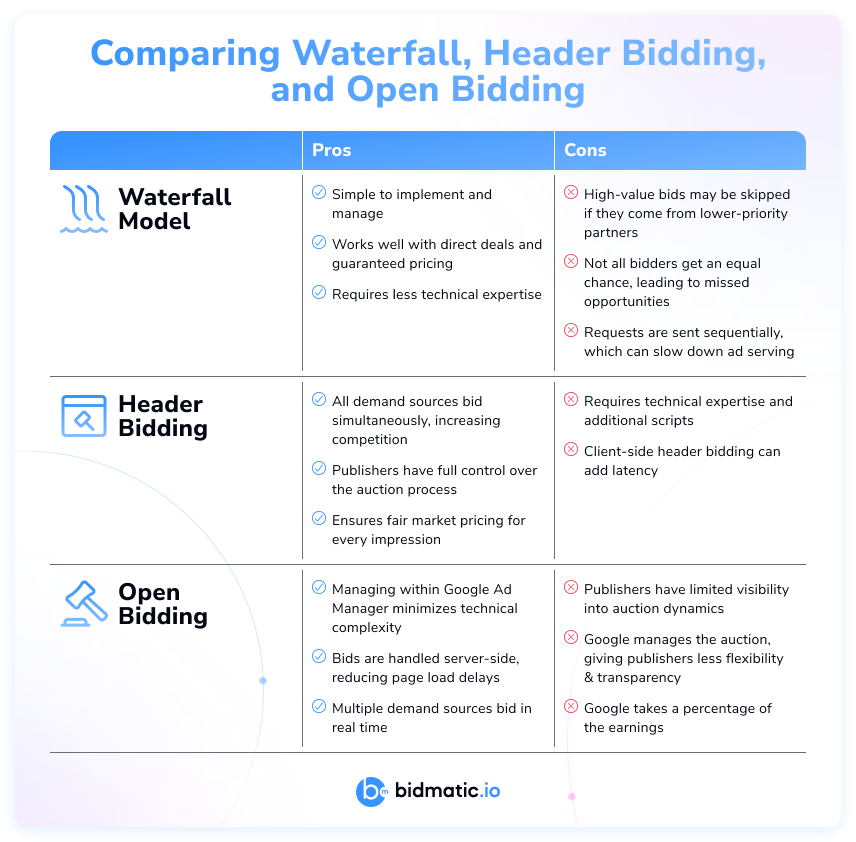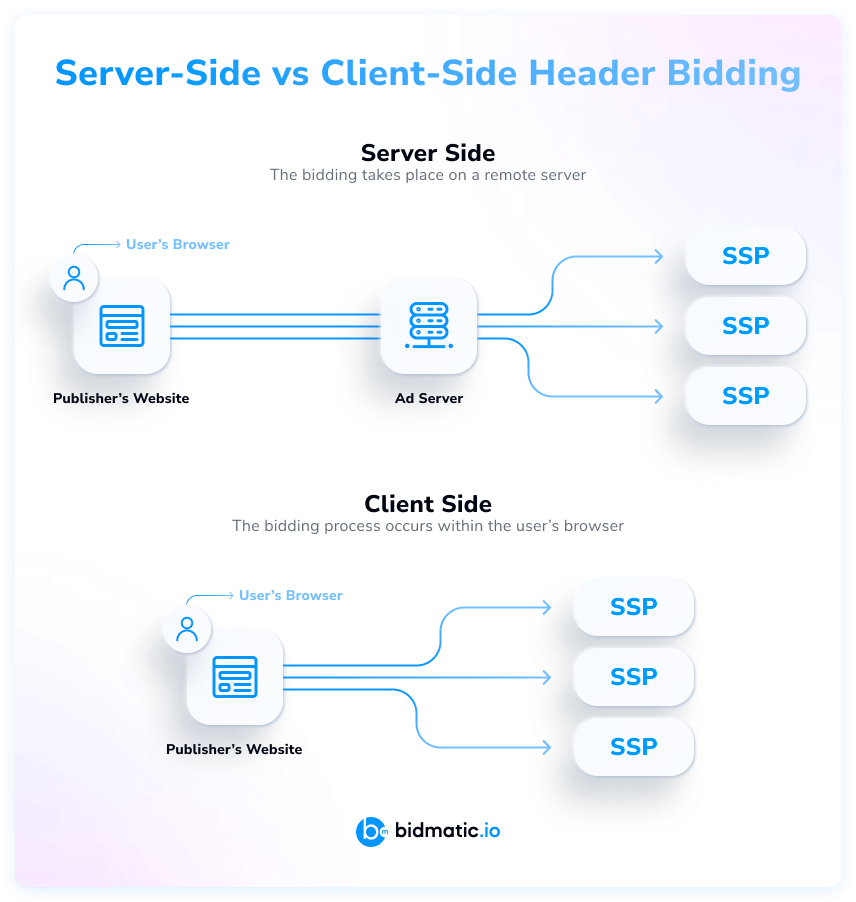
For instance, traditional waterfall auctions present two critical issues. First, they can limit your ability to select the partners you want to collaborate with. Second, the selling price of an impression often fails to capture its true worth. As a result, publishers miss opportunities to secure higher bids and maximize their earnings.
Header bidding, on the other hand, is a transformative technology that addresses these inefficiencies. It allows publishers to increase competition for their ad inventory and consequently enhance revenue.
This article will provide a detailed overview of header bidding, explain how it operates compared to other methods, and offer practical insights for publishers.
Introduction
Header bidding is an advanced programmatic advertising method for selling ad space that gives publishers greater control over the process, including the choice of buyers. Instead of selling impressions in bulk by the thousand, publishers can sell them individually.
This approach also allows publishers to collect valuable insights about buying habits and average budgets spent by advertisers, enabling them to make informed decisions about the value of their ad inventory.
How Header Bidding Works
It enables multiple demand partners (advertisers) to bid on ad impressions simultaneously before the publisher’s ad server decides. This ‘pre-auction’ takes place in the browser or on a server, ensuring maximum competition.

Let’s explore a step-by-step process:
- Header Bidding Wrapper Setup: A publisher adds a JavaScript code to their website.
- Ad Request Initiation: When a user visits a publisher’s website, the page sends an ad request to multiple advertisers (demand partners) through the header bidding wrapper.
- Simultaneous Bidding: Advertisers bid for the publisher’s ad inventory in real time, sharing their offers with the publisher’s ad server.
- Winning Bid Selection: The highest bid is forwarded to the publisher’s ad server, which determines the final ad placement based on predefined rules or priority settings.
- Ad Delivery: The ad is displayed to the user.
By enabling simultaneous auctions, header bidding maximizes competition and revenue and provides valuable insights into advertiser demand.
However, publishers should carefully monitor latency, partner quality, and overall performance to leverage its potential fully.

Header Bidding Models: Client-Side vs Server-Side
Client-Side
In this model, the bidding process takes place within the user’s browser. The publisher’s web page communicates directly with the demand partners (advertisers) using JavaScript embedded in the header.
While this approach can be effective, it, on the other hand, may lead to latency issues, especially when multiple demand partners are involved.
Server-Side
In contrast, server-side header bidding occurs on a remote server instead of in the browser. This method significantly reduces latency and improves page load times.
However, small publishers can often face challenges in effectively managing the complexities of server auctioning since implementing server-based header bidding requires a high level of expertise in server configurations and programmatic advertising.
If you require expert assistance, consider speaking to the Bidmatic team. By utilizing our technology, you will see the world’s largest advertisers competing against each other so that you can get the highest possible ad revenue.

Which One is Best for Publishers?
The ideal option is having them both, in other words — hybrid header bidding — an advanced programmatic advertising technique that combines client-side and server-side header bidding to optimize ad auctions. This approach enables publishers to maximize ad revenue while ensuring fast load times and a seamless user experience.
Why Publishers Choose Hybrid Header Bidding:
- Higher Revenue Potential — By allowing demand partners to compete from both the client side and server side, publishers can increase bid density and maximize CPMs.
- Improved Page Performance — By offloading some auction processes to a server, hybrid header bidding reduces latency, leading to faster load times and better user experience.
- Increased Demand Partner Access — Some advertisers perform better on client-side auctions, while others excel on the server side. Hybrid header bidding ensures maximum competition by enabling both types of bidders to participate.
- Better Cookie Matching & Fill Rates — Client-side bidding retains strong cookie-matching capabilities, and server-side bidding enables more simultaneous auctions, offering publishers higher fill rates and more personalized ads.
As ad tech continues to evolve, hybrid header bidding is becoming the go-to strategy for publishers looking to balance revenue growth, page performance, and advertiser demand. By leveraging this approach, they can unlock higher ad earnings without sacrificing user experience.


